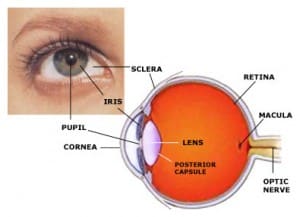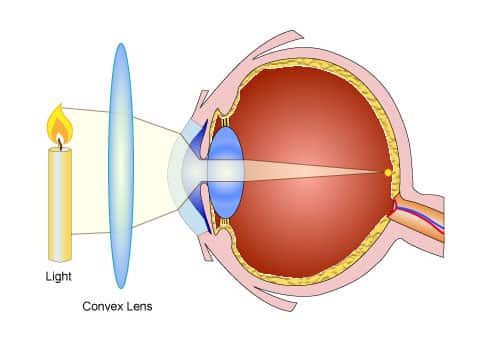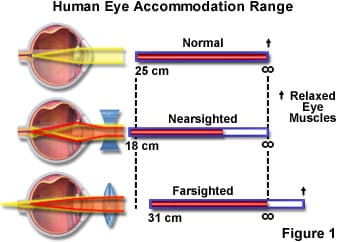Parts of the Eye
- The human eye is like a camera:

- Iris- like the diaphragm of a camera it controls the amount of light entering. It is the coloured part of the eye and opens and closes around a central hole to control the light entering the eye.
- Pupil- this is the hole in the iris. It is like the aperture in a camera which is where the light enters.
- Cornea and Lens- these cause light to converge creating a sharp image. The cornea is a transparent bulge on top of the pupil that focuses light. Light is refracted more through the cornea than the lens.
- Light sensitive cells- these cells act like the film in a camera, they “store” the image.
- Retina- converts light signals into electrical signals that will travel to the brain.
- Optic Nerve- used to transmit the signals from the retina to the brain.
Blind Spot?
- The optic nerve creates a blind spot at the back of each eye because there are no light-sensitive cells in this small area.
- You don’t notice your blind spots in normal vision because each eye compensates for the blind spot of the other eye. (Your left eye can see what is in the blind spot of your right eye and vice versa).
- The cornea-lens combination acts like a converging lens which produces an image with the following characteristics: Real, Smaller, and Inverted located on the retina.
- The brain takes the inverted image from the retina and flips it so what we see appears upright.
- The Eye as a Converging Lens:
Eye Accommodation
- The human eye cannot move its lens in and out like a camera.
- Eyes have evolved different ways of producing a clear image.
- Eye muscles, known as ciliary muscles, help the eye focus on a distant and near object by slightly changing the shape of the lens.
- This is known as Accommodation- changing the shape of the lens by way of the ciliary muscles alters the focal length of the lens creating a sharply focused image on the retina.
- A healthy eye will accommodate itself to view near and distant objects.
Focusing Problems
- For some people, the process of accommodation does not work well. There are 3 different problems we will look at.
Hyperopia (Far-sightedness)
- This person had no problem seeing objects in the distance but has trouble seeing nearby objects.
- The eye cannot refract light well enough to form an image on the retina.
- Usually occurs because the distance between the lens and the retina is too small or because the cornea-lens combination is too weak. Light from nearby objects focuses behind the retina.
- They need help refracting light.
- A modified converging lens is what they need.
- A Positive Meniscus Lens is like a converging lens except it is more cosmetically appealing but still maintains a middle that is thicker than the edge.
Presbyopia
- Presbyopia is the loss of accommodation due to old age, which results in far-sightedness.
- Unlike hyperopia, it is not a result of the eyeball being too short to focus.
- It can be corrected by glasses with a converging lens.
Myopia (Near-sightedness)
- This person can see close objects clearly but has trouble seeing distant objects.
- Usually occurs because the distance between the lens and the retina is too large or because the cornea-lens combination converges light too strongly.
- Light from distant objects is brought into focus in front of the retina.
- The eye can focus the image if the incoming light rays diverge. This can be accomplished with a diverging lens.
- Negative Meniscus Lens- is slightly modified, the edge of the lens is still thicker than the middle, but much more cosmetically appealing.
Contact Lenses
- A Contact Lens is a lens that is placed directly onto the cornea of the eye.
- They can be shaped so they can be used to correct far or nearsightedness.
- They can also be used strictly for cosmetic purposes.




good
Thank you, simple and to the point.
well done clearly understood.All parts needed done corectly